Due to its vast size — stretching from Canada and Greenland in the north, to Mexico in the south — North America contains a vast range of habitats. From land to sea, there are forests, mountains, deserts, open plains, and snowy tundras which are home to many fascinating animals, both large and small. But just what are the biggest animals in North America? Here we discover 10 of the largest animals in North America ranked by weight.
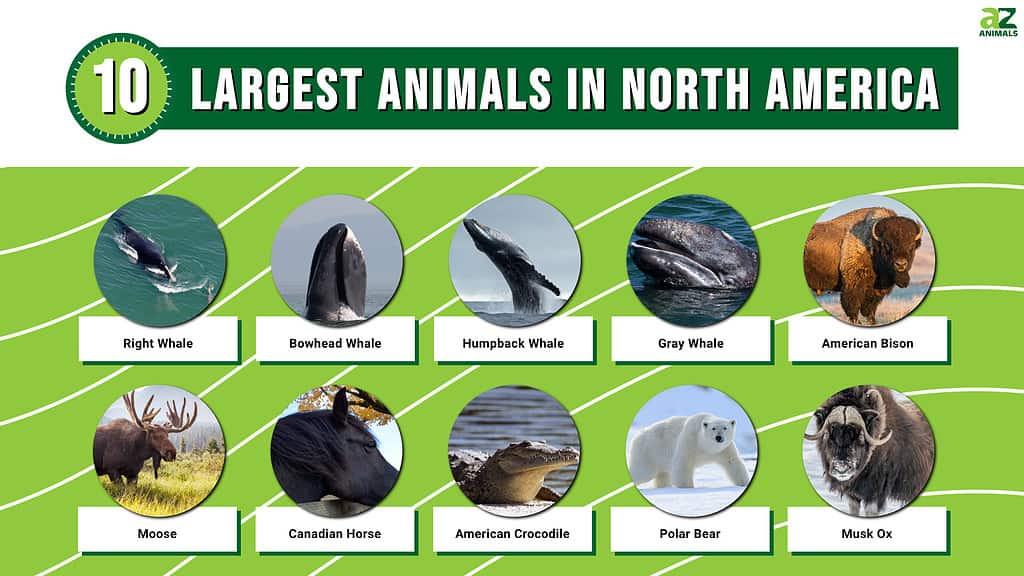
#10 Musk Ox
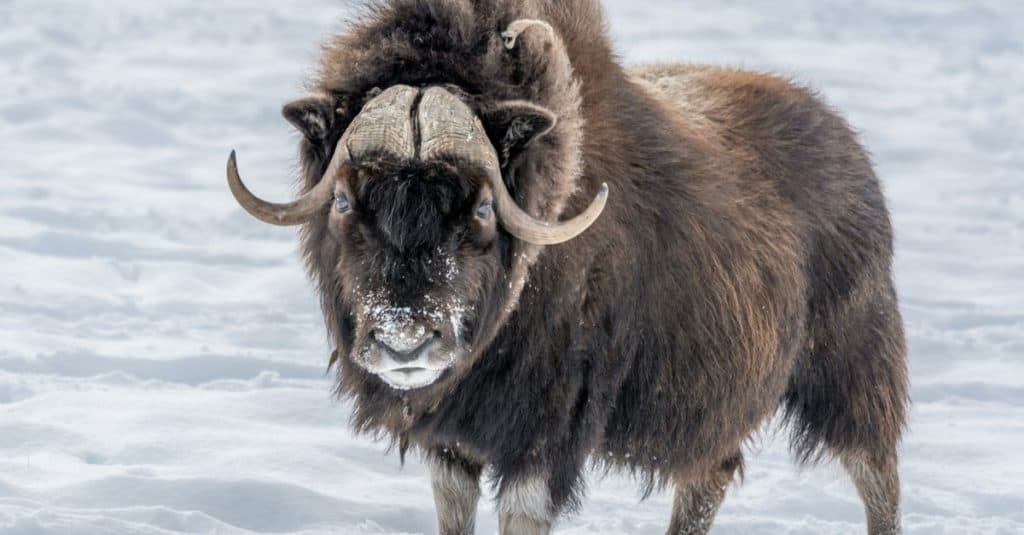
A musk ox can reach up to 900 pounds.
©Fitawoman/Shutterstock.com
Musk ox are a member of the Bovidae family and can reach sizes of up to 900 pounds. They are native to the Arctic, but are widespread across Greenland and Canada, and have also been reintroduced to Alaska, Norway, and Sweden. Although their name suggests they are ox, they are actually more closely related to sheep and goats. Musk ox have thick, dark coats and curved horns on each side of their head, giving them an intimidating appearance. These unusual animals are herbivores and live in herds of around 15 to 20 animals where hierarchy is determined by age, with the older animals being dominant over the younger ones. Musk ox are extremely defensive if they are threatened and will form a protective circle around nursing females and calves.
#9 Polar Bear
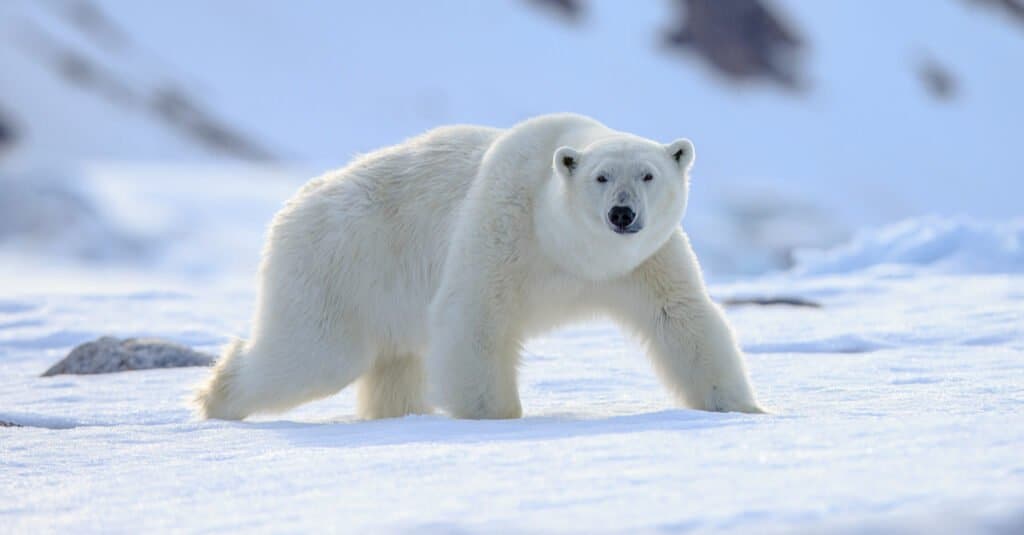
Polar bears, which actually have black skin, can grow to around 990 pounds.
©Vaclav Sebek/Shutterstock.com
Polar bears are large carnivorous bears that inhabit several areas of North America — including Alaska, Canada, and Greenland — as well as Russia and some Norwegian islands. Considered to be the largest bears around, male polar bears reach weights of around 990 pounds. Polar bears are well known for their distinctive white appearance, however, their skin is actually black and their fur is translucent but appears white because it reflects the sunlight. Polar bears are excellent swimmers and spend much of their time either on the sea ice or in the ocean and have a water-repellent coat and a thick layer of body fat to keep them warm. They mainly eat seals, often waiting for hours for a seal to rise to the surface at a hole in the ice. Sadly, due to climate change and overhunting, polar bears are now classed as vulnerable species.
#8 American Crocodile
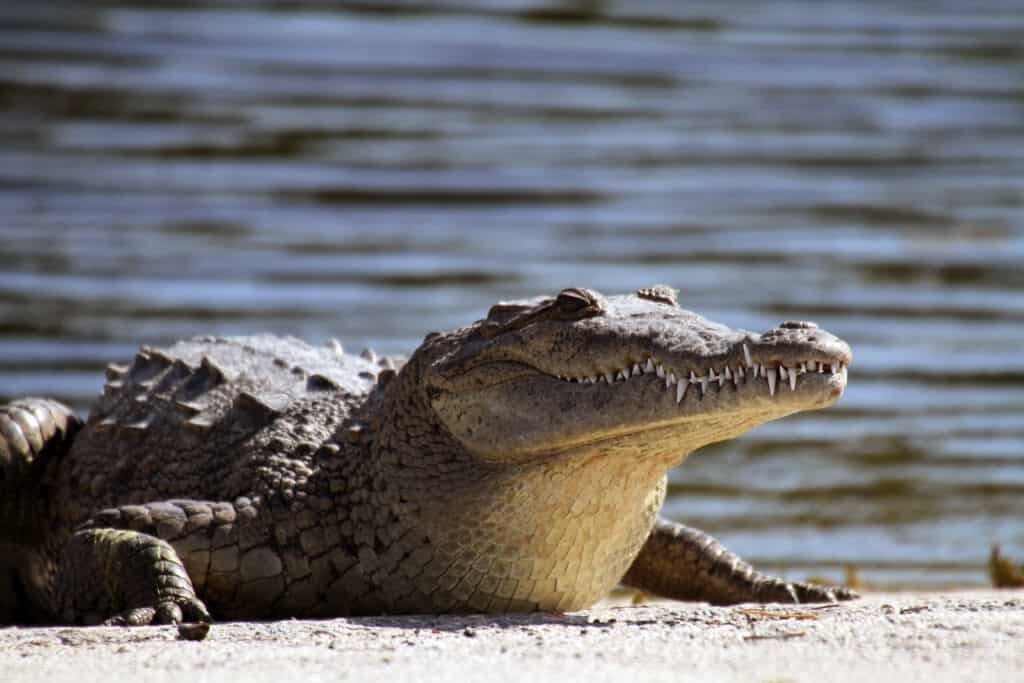
Male American crocodiles weigh on average around 1,000 pounds.
©iStock.com/GriffinGillespie
With an average weight of around 1,000 pounds for males, American crocodiles are some of the largest crocodiles around. Although females are significantly smaller than males, they can still reach lengths of around 13 feet, and with their strong jaws and impressive teeth, they’re certainly not an animal to be taken lightly. American crocodiles are widespread across Florida, Cuba, and Jamaica and prefer to live in coastal areas, and they are the only species other than the saltwater crocodile to live predominantly in saltwater. These crocodiles have a grey-green back, a fairly broad snout, and a stocky, powerful build. American crocodiles are capable of hunting on land and in the water and eat a variety of prey, including fish, crabs, snakes, frogs, birds, and small mammals.
#7 Canadian Horse
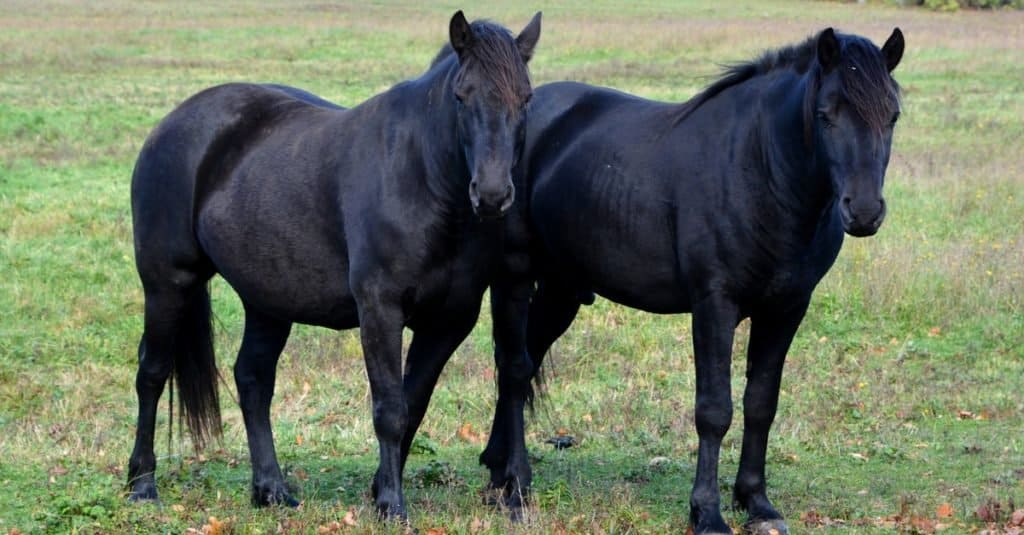
Canadian horses are a strong and muscular breed and typically weigh 1,000-1,400 pounds.
©meunierd/Shutterstock.com
Canadian horses are a breed of horse that is native to Canada and usually weigh between 1,000 and 1,400 pounds. They are strong, muscular horses and are usually bay, brown, or black and have a calm temperament which makes them excellent riding horses. The breed was originally formed from the horses that Louis XIV sent to Canada in the 17th century which were a mixture of Andalusians, Arabs, and Barb horses. During the 19th century, many Canadian horses were used as cavalry horses during the American Civil War where many of them were killed and the breed almost became extinct. Thankfully, the numbers did improve and the breed has so far managed to survive, although they are still in danger and are officially critically endangered.
#6 Moose
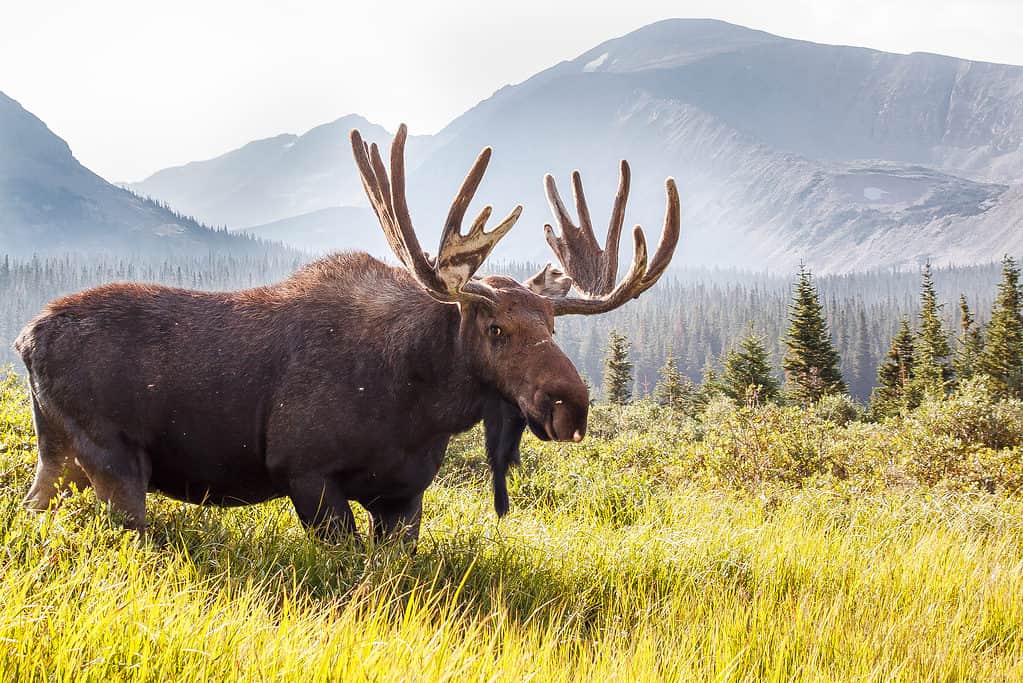
The moose is capable of reaching 1,500 pounds.
©Michael Liggett/Shutterstock.com
Moose are widespread across North America and are the largest member of the deer family, with males capable of reaching weights of 1,500 pounds. They generally live in forests and eat a range of plants and vegetation. Moose are easily recognized by their dark brown color and their dewlap (a flap of skin hanging underneath their chin). Male moose grow antlers which are wide and broad and are shed after the mating season, before growing a new set in the spring. Moose are able swimmers and are even able to eat underwater as they have the ability to close their nostrils using their muscles to prevent water from entering them. Although they are usually able to defend themselves well, the main predators of moose are bears and wolves, with packs of wolves usually targeting the calves.
#5 American Bison

The American bison is the largest land mammal in North America.
©iStock.com/Jillian Cooper
American bison, also known as American buffalo, is the largest land mammal in North America, with males weighing up to 2,100 pounds, and females up to 1,200 pounds. These large mammals are dark brown, with especially long hair around their face, have short, curved horns, and a distinguishable hump on their shoulders. American bison are the national mammal of the US and used to roam across most of North America but are now only found wild in national parks. They prefer to live in grasslands and open plains and are herbivores, grazing long grass even while on the move. American bison live in herds, which are separated by gender for most of the year — with males in one herd and females and calves in another — and only merge during the breeding season. Despite their size, bison calves are still at risk from wolf packs and grizzly bears.
#4 Gray Whale

The gray whale weighs in at around 60,000 pounds.
©Mogens Trolle/Shutterstock.com
Not forgetting the animals that spend their lives in the waters around North America, the top spots are filled by whales, with the gray whale weighing in at around 60,000 pounds. Gray whales are baleen whales that usually live in the coastal waters of the North Pacific Ocean, although they do sometimes migrate into deeper waters, and there is a population of them in the western North Pacific (Asian population). They have a streamlined body that is grey with mottled white patches and is unique as they have two blowholes. Gray whales feed by rolling onto their side and scooping up sediment from the ocean floor and filtering it through their baleen plates so they can eat the crustaceans that have been scooped up with it. Due to their size, the only natural predators that grey whales have are sharks and killer whales.
#3 Humpback Whale
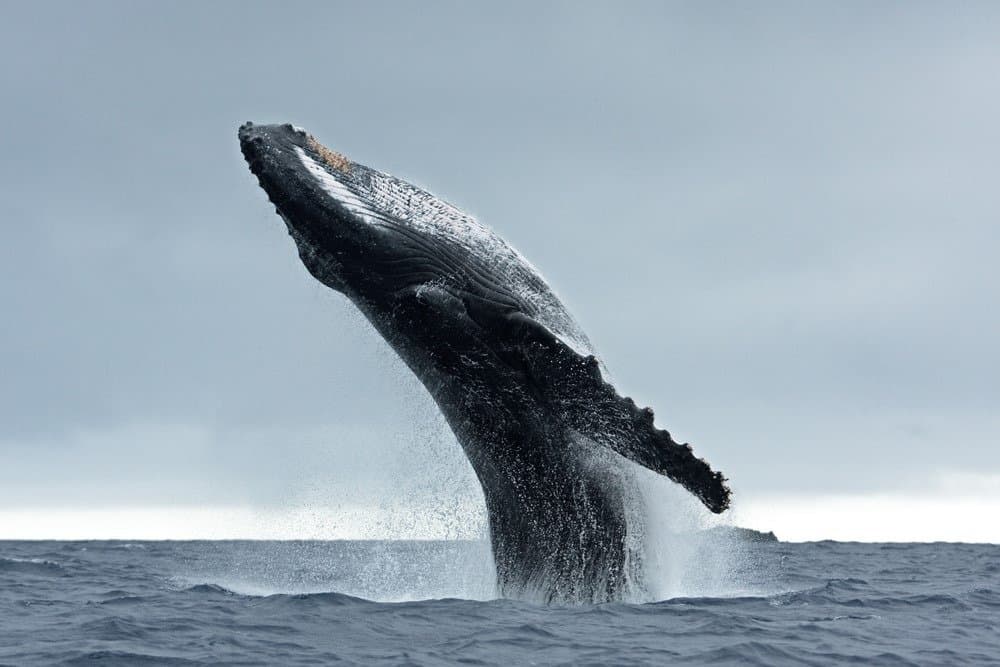
A humpback whale can grow to about 20 feet long.
©Martin Prochazkacz/Shutterstock.com
Humpback whales are also baleen whales and can reach weights of 66,000 pounds and lengths of around 20 feet. Although they are found in most major oceans, there are several populations of them that live in the waters around North America, including four populations in the North Pacific Ocean. Humpback whales are usually black but can have white patches on their fins, bellies, and tails. These whales are a favorite with whale watchers as they often breach (jump out of the water), creating an impressive sight. Humpback whales feed on krill and small fish and create bubbles from their blowholes while swimming in a spiral pattern to create a “net” around the prey before swimming up through the center of it to feed.
#2 Bowhead Whale
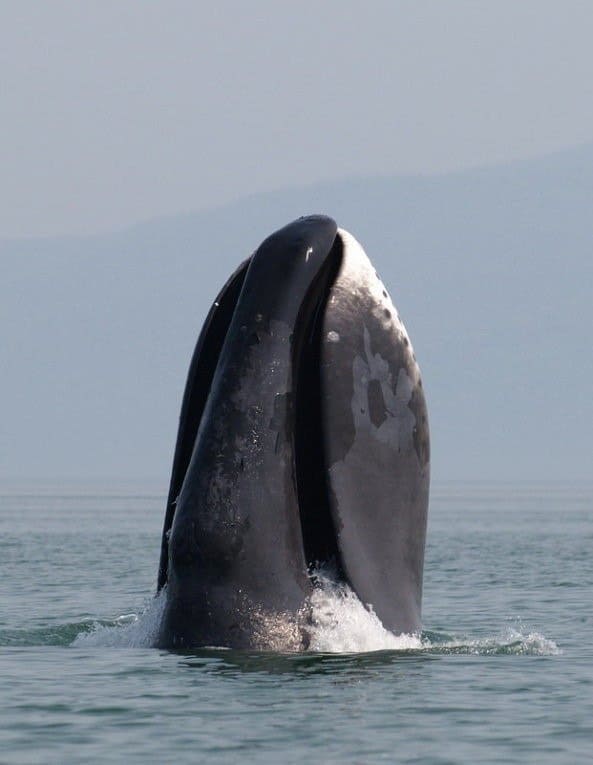
A bowhead whale can reach up to about 120,000 pounds.
©Olga Shpak / CC BY-SA 3.0, via Wikimedia Commons – Original / License
The bowhead whale is another baleen whale that lives in the waters around Canada and Greenland. Reaching weights of around 120,000 pounds, the bowhead whale is a huge whale that is easily recognized by its dark body and large head with a white chin. Bowhead whales are well equipped for life in icy waters as they use their large heads to break through ice that is sometimes up to seven inches thick. It’s not just their bodies that are large either as bowhead whales have the longest baleen plates of any whale which they use to filter krill and small fish through.
#1 Right Whale

The North Atlantic right whales can grow up to 155,000 pounds and is the largest animal in North America.
©iStock.com/6381380
The largest animal in North America is the right whale. There are three species of a right whale and two of them — the North Atlantic and the North Pacific right whale — are found in the waters surrounding North America. The North Atlantic right whale can reach weights of up to 155,000 pounds, while the North Pacific right whale is heavier at 175,000 pounds. Right whales are also baleen whales and both species are large, black whales with patches of white on their bellies. Both species feed on zooplankton which they eat by swimming through it with their mouths open, also known as skimming. Sadly, due to threats such as vessel strikes, entanglement in fishing nets, and climate change, right whales are under threat. There are fewer than 400 North Atlantic right whales left in the world and they are critically endangered, while North Pacific right whales are also endangered.
Summary of the 10 Largest Animals in North America
Here is a list of the largest animals in North America:
| Rank | Animal | Size |
|---|---|---|
| 1 | Right Whale | 155,000-175,000 lbs |
| 2 | Bowhead Whale | 120,000 lbs |
| 3 | Humpback Whale | 66,000 lbs |
| 4 | Gray Whale | 60,000 lbs |
| 5 | American Bison | 1,200-2,100 lbs |
| 6 | Moose | 1,500 lbs |
| 7 | Canadian Horse | 1,000-1,400 lbs |
| 8 | American Crocodile | 1,000 lbs |
| 9 | Polar Bear | 990 lbs |
| 10 | Musk Ox | 900 lbs |
The photo featured at the top of this post is © O.S. Fisher/Shutterstock.com
Thank you for reading! Have some feedback for us? Contact the AZ Animals editorial team.







